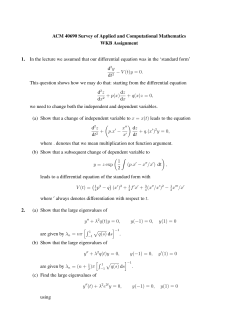
Laplace Transforms
Math 136 Fall 2014
Problem Set 9
Prof. Bernoff
Laplace Transforms
Due date: Tuesday, November 18th in class.
I1: Consider the differential equation problem
f 00 (t) + f (t) = t
for t > 0,
subject to the initial conditions f (0) = f 0 (0) = 0.
(a) Use Laplace transforms to show that
F (s) = L [f (t)] =
1
.
+ 1)
s2 (s2
(b) Use residue calculus to compute f (t) = L−1 [F (s)].
I2: Use Laplace transforms to find the general solution for y(t) to
y 00 + 2αy 0 + ω 2 y = 0
y(0) = 0
y 0 (0) = 1
Where ω > 0 and α > 0. Evaluate the inverse transforms via the residue theory (and
remember your answer should be a real function). Make sure you consider the three cases:
(i) ω > α (under-damped), (ii) ω = α (critically damped), and (iii) ω < α (over-damped).
Graph a typical solution for each case.
I3: For this problem it will be helpful to know the definition of the Γ-function,
Z ∞
Γ(p) =
up−1 e−u du
for Re{p} > 0.
u=0
We will use this to generalize the formula
L [tn ] =
n!
sn+1
n = 0, 1, 2 · · ·
to non-integer values.
(a) Show that Γ(1) = 1. Show via integration by parts that Γ(β) = (β − 1)Γ(β − 1) for
Re{β} > 0. Use these two facts and induction to show that Γ(n) = (n − 1)!
(b) Show that
Γ(β + 1)
L tβ =
sβ+1
where Re{β} > −1. The change of variables st = w may be useful. Check that your
answer agrees with the result above when β is a non-negative integer.
(please turn over)
Math 136 Fall 2014
Problem Set 9
Prof. Bernoff
(c) Let’s now derive the associated inverse formula. Use the Mellin inversion formula to
calculate L−1 [1/sα ] for 1 > Re{α} > 0. To do this you will need to deform the
Bromwich contour around the branch cut on the negative real axis and make sure their
are no contribution from the branch point at the origin or the portion of the contour
at infinity. Your answer should imply that
Γ(1 − α) sin πα α−1
1
−1
=
t .
L
α
s
π
(d) From your two answers deduce the reflection identity for the Γ-function,
Γ(α)Γ(1 − α) =
π
sin πα
for 1 > Re{α} > 0.
Can you deduce the value of Γ(1/2) from this formula?
I4: Let p(t) is the triangle wave function of period 2π illustrated below.
The triangle wave p(t)
1
p(t)
0
⇡
2⇡
3⇡
4⇡
t
(a) Explain why
∞
t
2X
p(t) = +
(−1)n H(t − nπ)(t − nπ).
π π n=1
(b) Determine an explicit formula for P (s), the Laplace transform of p(t). You will need
to evaluate the infinite sum by observing that it is a geometric series.
(c) Determine a Fourier series for p(t) by computing the inverse Laplace transform of P (s)
as a sum over an infinite number of residues. Show that your answer can be written as
a sum of cosines (with real coefficients).
(please turn over)
Math 136 Fall 2014
Problem Set 9
Prof. Bernoff
I5: A delay differential equation is a type of differential equation in which the derivative of the
unknown function at a particular time is determined by the value of the function at previous
times. Delay differential equations come up in many areas of science and engineering. For
example, compartment models for medication in the body often involve delay differential
equations because the delays associated with medication metabolism are significant.
In this problem, you will analyze the delay differential equation
y 0 (t) = −y(t − τ )
for t ≥ 0
subject to the initial conditions that y(t) = 0 for t < 0 and y(0) = 1. Here the delay, τ , is
a positive number and as τ increases the solution goes from decaying monotonically, to an
oscillatory decay, and finally to over-stability where we observe oscillatory growth.
(a) Define Y (s) = L [y(t)] and apply the Laplace transform to the delay differential equation. Solve the resulting equation for Y (s).
(b) We know that for t > 0,
−1
y(t) = L
1
[Y (s)] =
2πi
Z
c+i∞
est Y (s)ds = sum of residues of est Y (s).
c−i∞
However, this inverse Laplace transform is difficult to compute because Y (s) has an
infinite number of poles in the complex s plane. Fortunately, it turns out that with
only one or two residues one can get an excellent approximation to y(t). One can use
this approximation to determine the behavior of y(t) as t → ∞.
When τ is small, approximate the exponential e−sτ = 1 − sτ to find a one-pole approximation for the solution. Show this solution is monotonically decaying as t → ∞.
(c) One can find the value of τ that is the threshold of oscillations by finding the smallest
value of τ where the singularity with largest real part is a pole of order two which
corresponds to critical damping. Determine this value of τ and an approximation for
the solution at this point.
(d) One can find the value of τ that is the threshold of instability by finding the smallest
value of τ where there are a pair of poles on the imaginary axis at ±iω. Determine this
value of τ and an approximation for the solution at this point.
(e) Extra credit: Use the MAPLE worksheet delay.mw to calculate other poles of Y (s)
so as to produce a more accurate approximation to Y (s). Experiment with how accurate you can/need to make your approximation to y(t) and determine how good the
approximations in parts (b-d) are.
© Copyright 2025





















